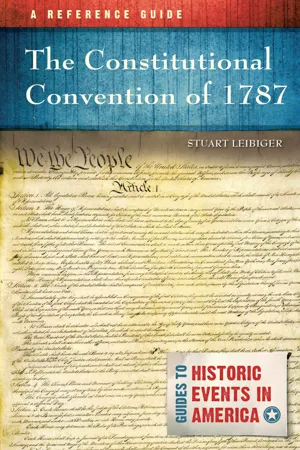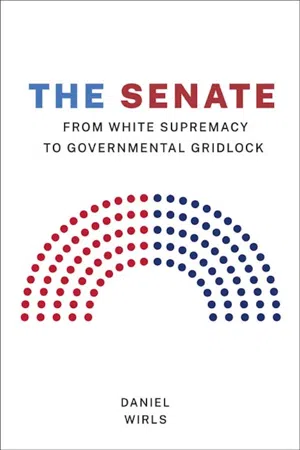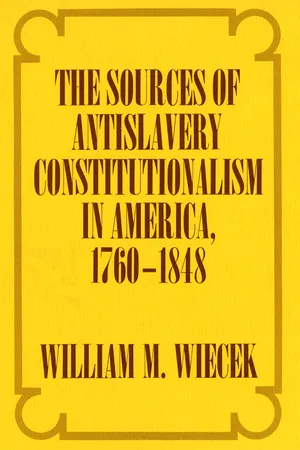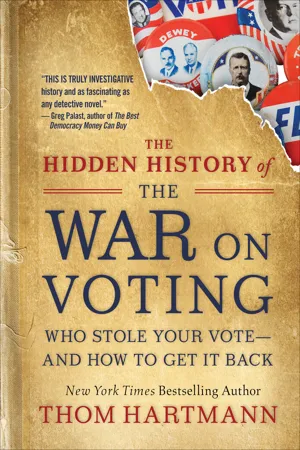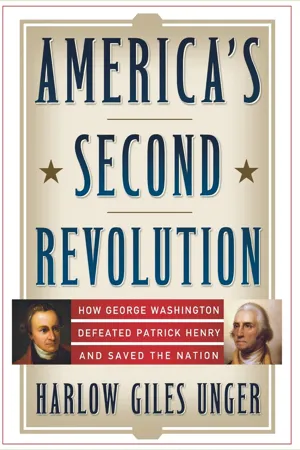History
The Three-Fifths Compromise
The Three-Fifths Compromise was a decision made during the Constitutional Convention of 1787 in the United States. It determined that three-fifths of the slave population would be counted for the purposes of taxation and representation in Congress. This compromise was a significant factor in the ongoing debate over slavery and representation in the new nation.
Written by Perlego with AI-assistance
Related key terms
5 Key excerpts on "The Three-Fifths Compromise"
- eBook - ePub
The Constitutional Convention of 1787
A Reference Guide
- Stuart Leibiger(Author)
- 2019(Publication Date)
- ABC-CLIO(Publisher)
57On July 11, the convention voted down the three-fifths ratio, six states to four, with only Connecticut, Virginia, North Carolina, and Georgia in favor. This vote is often portrayed as a devastating blow to the slaveholding states that quickly forced them to make a concession to the North to get The Three-Fifths Compromise restored. According to this interpretation, the South the next day agreed to a motion by Gouverneur Morris that taxes on the states would be apportioned the same way as population. True, Morris a few days later hinted that his motion had indeed been designed to help restore The Three-Fifths Compromise. The problem with this interpretation is that the defeat of The Three-Fifths Compromise was not inflicted by the North on the South. Instead, it was inflicted by the South on itself. South Carolina and Maryland voted against The Three-Fifths Compromise, the former because it wanted slaves to count as five-fifths of free people, and Maryland because of a technicality over the wording of the resolution. The South thus did not need to make concessions to the North to overturn the vote, but it simply needed to vote in unison to restore The Three-Fifths Compromise. The Morris resolution, moreover, only got one northern state, Pennsylvania, to change its vote, and that ended up being a vote the South did not ultimately even need to restore The Three-Fifths Compromise.58The Lower South delegates, however, vociferously demanded representation in the lower house for their enslaved population. “It was high time now to speak out,” proclaimed Davie. “It was meant by some gentlemen to deprive the Southern States of any share of Representation for their blacks.” North Carolina would accept nothing less than counting enslaved people as three-fifths of free people. Butler explained that “the security the Southn. States want is that their negroes may not be taken from them, which some gentlemen … have a very good mind to do.” - eBook - ePub
Constitutionalism and Democracy
From White Supremacy to Governmental Gridlock
- Daniel Wirls(Author)
- 2021(Publication Date)
- University of Virginia Press(Publisher)
13 The greatest compromise might have softened the way for the Great Compromise, even if that is difficult to discern in the voting by states and individual delegates.The extra representation in the House might have made it easier for some large-state southern convention delegates to accept equality in the Senate; in turn, the potential domination of the House by the South might have given some northerners a reason to accede to senate equality.14 The potential power of the South in the House—and Virginia was by some margin the largest state—was another argument for making the Senate into a northern institution. At the convention, there were six “northern” or border states that were free or with insignificant enslaved populations and six southern or border states with significant enslaved populations.15 And if the convention succeeded and Rhode Island, which did not send delegates to Philadelphia, joined the union, then the balance would be seven to six. That small initial northern advantage in the Senate seemed likely to grow sooner rather than later with the transformation of the Northwest Territories into states, states that were preordained to be free by the Northwest Ordinance. But that is not how the nation evolved in its initial decades.The irony is that it did not take long for the tables to turn as northern states gained population much faster than southern states. This was not due to the admission of new states. The original six “slave” states had at the start a slim population advantage over the seven northern states, now including Rhode Island (by about 65,000 residents, according to the 1790 census). Only twenty years later those same seven northern states, with New York and Pennsylvania leading the way, had over half a million more residents than the original group of slave states. This was the census head count including all slaves, not the apportionment population with enslaved populations counted by three-fifths. And in the 1810 census, enslaved individuals accounted for 37 percent of total population of the original six slave states, not counting Kentucky and Tennessee, which had been added to their ranks.16 - William M. Wiecek(Author)
- 2018(Publication Date)
- Cornell University Press(Publisher)
23Madison, writing for a northern audience in Federalist Number 54, expanded on this point. He reviewed the basic northern argument against fractional slave representation: because the southern states considered the slaves property, they should be included in the enumeration for tax purposes at one hundred percent, and excluded altogether for apportionment purposes. To this, he replied, “the true state of the case is, that they partake of both these qualities; being considered by our laws, in some respects as persons, and in other respects, as property.” Therefore, “let the compromising expedient of the Constitution be mutually adopted, which regards them as inhabitants, but as debased by servitude below the equal level of free inhabitants, which regards the slave as divested of two-fifths of the man.” This was an odd, yet not altogether illogical way of putting it, though Madison admitted that some of these arguments were “a little strained in some points.”24The federal number clause provoked surprisingly little debate in the ratifying conventions. In the South, Federalists touted its advantages, arguing that it was at the least “the only practicable rule or criterion of representation,” and at best “an immense concession in our favour.”25 In the North, Federalists faintly apologized for it along the lines of Madison’s Federalist 54.26Carefully wrought as the compromise over fractional slave representation was, it was almost undone by the overreaching of the deep-South bloc in the matter of the foreign slave trade. The Carolinians’ inflexibility in this matter brought on the second crisis of the Convention. The slave trade was a sensitive topic.27 Spokesmen of the upper South considered it an “inhuman traffic,” and George Mason played Cassandra when he warned that “the Western people are already calling out for slaves for their new lands; and will fill that Country with slaves if they can be got thro’ S. Carolina & Georgia.”28 Yet the South Carolinians unapologetically insisted on its necessity for their state and Georgia. They needed the trade if they were to expand their slave population significantly by any means other than natural increase. Between 1735 and 1775, six out of seven slaves imported into South Carolina came from Africa, one from the islands, and only a statistically insignificant number from other mainland colonies.29 Carolinians argued that the New Englanders and Virginians, who were the most vocal critics of the trade, were estopped from condemning them for wanting to keep it open, the Virginians because of their obvious self-interest—with the trade closed, the prices of Virginia’s slaves would rise—and the New Englanders because so much of the trade had been, and still was, carried in New England bottoms. Indeed, if men like John Brown, a merchant of Providence, Rhode Island, and brother of the Quaker abolitionist Moses Brown, had their way, New England slavers would ply their trade as long as the New World provided a vent for it: “This Trade has been permitted by the Supreame Govenour of all things for time Immemmoriel and … allowed by all the Nations of Europe… . I cannot thinke this State ought to Decline the Trade.”30- eBook - ePub
The Hidden History of the War on Voting
Who Stole Your Vote—and How to Get It Back
- Thom Hartmann(Author)
- 2020(Publication Date)
- Berrett-Koehler Publishers(Publisher)
10Like The Three-Fifths Compromise, the form of the Senate was the result of slavery as much as it was a conflict between large and small states. After all, several of the slave states, when their black population was excluded, had a similar number of white male voters as the medium-sized Northern states.Samuel Thatcher of Massachusetts objected bitterly, saying, “The representation of slaves adds thirteen members to this House in the present Congress, and eighteen Electors of President and Vice President at the next election.”11Nonetheless, America continued to elect slaveholders to the White House all the way through the presidency of Andrew Jackson, in large part because of both the undemocratic nature of the Senate and The Three-Fifths Compromise.The 15th Amendment resolved the three-fifths issue on paper, but the issue of how each state having two senators skewed the Electoral College persisted.In 1934, the Senate came within two votes of the two-thirds necessary to pass a constitutional amendment to the states to eliminate the Electoral College and go to direct election of the president. Senator Alben Barkley, D-Kentucky (later Harry Truman’s vice president), stated, “The American people are qualified to elect their president by a direct vote, and I hope to see the day when they will.”12 - eBook - ePub
America's Second Revolution
How George Washington Defeated Patrick Henry and Saved the Nation
- Harlow Giles Unger(Author)
- 2007(Publication Date)
- Trade Paper Press(Publisher)
Theorizing that Washington may well have helped author Hamilton’s “monarchic” proposals, some delegates began edging toward compromise. As their first step, they reconsidered Roger Sherman’s Connecticut Compromise, which they had rejected on June 11. As three large states—Virginia, Massachusetts, and Pennsylvania—edged toward compromise with three small states—Connecticut, New Jersey, and Delaware—New York’s two remaining delegates—both Antifederalists—stomped out in protest, leaving only ten states in attendance. To make matters worse, the two New Yorkers violated the secrecy rule of the Convention by reporting all details of Convention proceedings to New York governor George Clinton, whom Hamilton blamed for the walkout. Clinton had, in fact, held his office for ten years and accumulated enormous power and wealth that he feared he would lose if a strong national government acceded to office.On July 16 the remaining delegates in Philadelphia put aside their personal dislikes of the man and adopted Roger Sherman’s Connecticut Compromise and solved the hitherto insoluble problem of voting in the two houses by establishing proportionate representation in the lower house and parity in the upper house, but giving the lower house sole right to originate appropriations legislation. Each state in the lower house would cast votes proportionate to the total of its free population and three-fifths of its slave population, while each state in the upper house would have but one vote, giving the small states parity with large states. But the South wanted more—a requirement of a two-thirds vote in the Senate for ratification of all treaties with foreign nations. Southerners had not forgotten that only two years earlier, northern states in Congress had almost ceded American navigation rights on the Mississippi River to Spain—rights that were “essential to the prosperity and happiness of the western inhabitants” of Virginia and the other southern states, whose western portions extended to the Mississippi River. Although the northern majority in Congress had approved the treaty by a bare majority, the Articles of Confederation had protected southern interests by requiring approval by nine of the thirteen states to ratify treaties. The South insisted on—and won—the same protection in the new Constitution.
Index pages curate the most relevant extracts from our library of academic textbooks. They’ve been created using an in-house natural language model (NLM), each adding context and meaning to key research topics.
